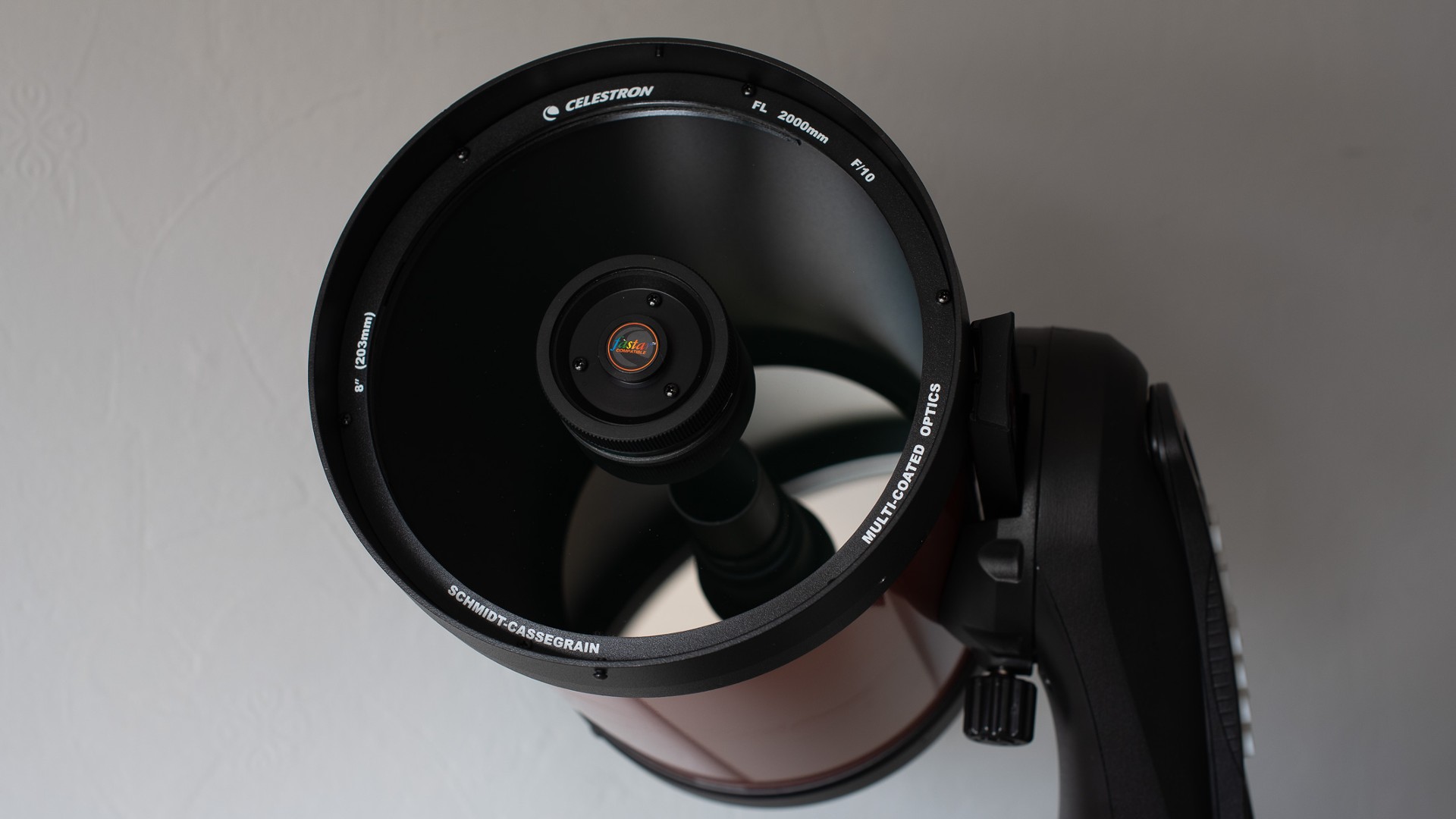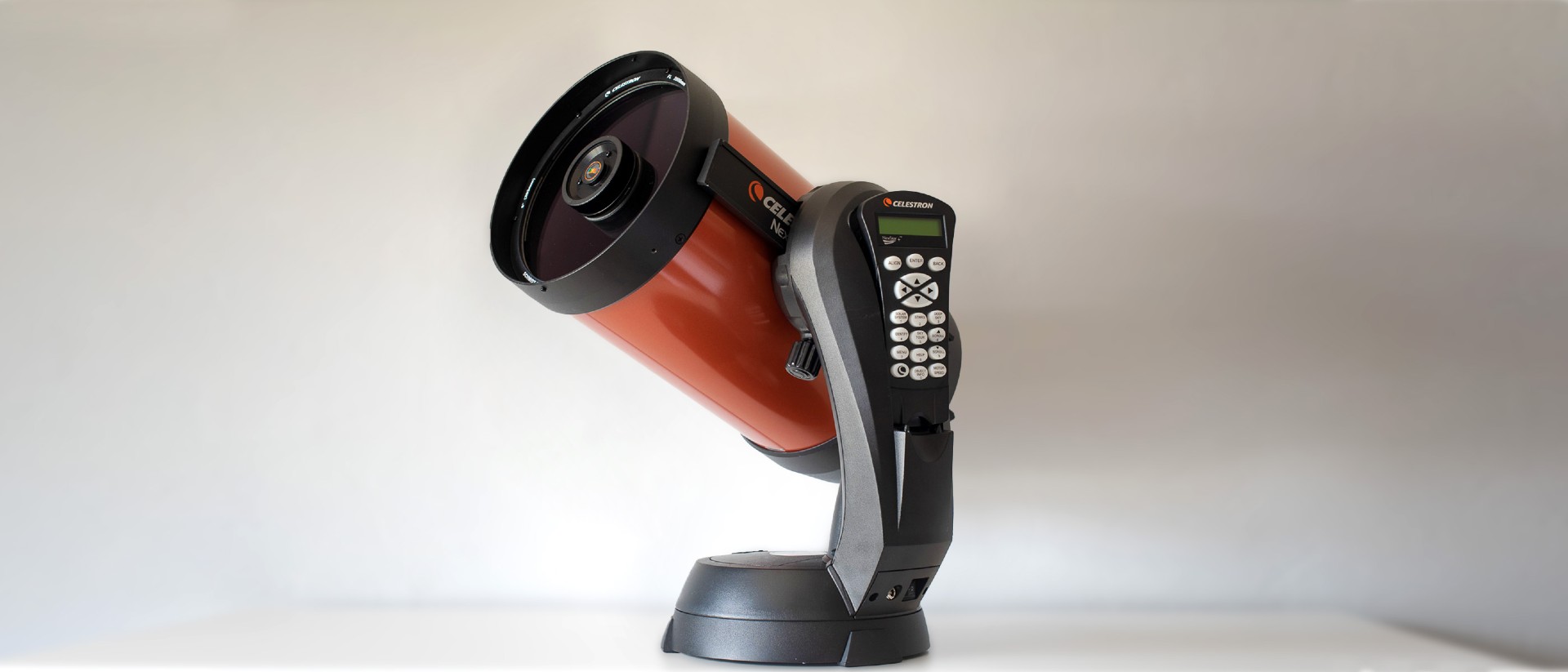Live Science Verdict
Beginner astronomers could go their whole lives without swapping out this telescope for another, and intermediate or advanced astronomers will benefit from the go-to motorized function and scalability with additional accessories. Though, casual astronomers with tighter budgets may want to look for something cheaper.
Pros
- +
Extremely bright, sharp views
- +
Reasonable value for money
- +
Strong, sturdy tripod feels rock solid
Cons
- -
Beginners may struggle at first
- -
Definitely not a budget telescope
Why you can trust Live Science
Mount type: Computerized Altitude-Azimuth Single Fork Arm
Optical design: Schmidt-Cassegrain
Aperture: 8 inches (203.2 mm)
Focal length: 80 inches (2032 mm)
Focal ratio: f/10
Highest useful magnification: 180x
Total kit weight: 32 lbs (14.48 kg)
The Celestron NexStar 8SE Computerized Telescope is a fully automated, motorized go-to telescope perfect for viewing deep-sky objects, the moon, and even planets. A versatile Schmidt-Cassegrain design, this telescope is small and compact for its light-gathering ability. Drinking in light with its 8-inch aperture, it’s powered by a motorized mount that smoothly moves with the touch of a button from the built-in hand control. Once aligned, simply dial in the correct code to have the 8SE navigate to a desired night sky object for observation.
Bright and sharp, this telescope is best used with a variety of eyepieces. Intermediate to advanced astronomers will likely want to add to the telescope with their favorite accessories and Barlow lenses. It’s not cheap, but what you get for the price is a fantastic night sky observing instrument that won’t let you down. Beautifully painted in its orange jacket, there’s no mistaking the Celestron NexStar 8SE and we think this is definitely one of the best telescopes out there for experienced stargazers.
Grab one of the best astronomy books alongside this telescope and you’ll be navigating your way around the skies in no time.
Celestron NexStar 8SE Computerized Telescope review: Design

- Single fork arm has integrated NexStar+ hand controller
- Motorized mount has neat battery compartment
- Clutter-free instrument exterior
Aside from the much loved and notable NexStar series orange tube, the main design feature of the Celestron Nexstar 8SE is its compactness and clutter-free workspace. Part of the Schmidt-Cassegrain charm is that this catadioptric construction benefits from shortening the tube length whilst maintaining a long focal length to capture bright images of distant dark sky objects.
Celestron has done well to keep everything clear and ready for the intermediate astronomers to add their desired accessories. A single fork mounting arm leaves plenty of space on the right side of the telescope when viewing from the eyepiece and the in-built NexStar+ hand control fits right inside the fork arm where it rests ready to be used — whether on the arm or in the hand via the connected coiled cord.

It ships with a single star diagonal for right-side-up (though mirrored) projection through the eyepiece. Its 25 mm eyepiece has orange font to match the tube color, which we think is a nice touch. The Star Pointer finderscope is easy to attach and align and sits firmly on the side of the tube, giving us confidence when aligning the telescope.
The tripod feels sturdy and strong enough to support the rather heavy mount and we like the way it slots into three set screws that each have thumb grips on for easy tightening. This feels incredibly secure and the metal accessory tray that slots in between the legs helps when changing eyepieces or diagonals.
Get the world’s most fascinating discoveries delivered straight to your inbox.
Celestron NexStar 8SE Computerized Telescope review: Performance

- Stunning clarity thanks to excellent optical characteristics
- Motorized feature is smooth
- Hand controller feels solid in the hand
Schmidt-Cassegrain telescope designs are known for their impressive optical quality and the Celestron NexStar 8SE Computerized Telescope reinforces this stereotype. A big 8-inch aperture up front simply drinks in light and makes it incredibly easy to see detail in the night sky. We tested the telescope in midsummer in the northern hemisphere which made it tricky to get a decent dark, night sky view (thanks to the fact there was no actual ‘night’ during our observing time) so we focused mainly on observations of the moon.
Using the 25 mm eyepiece it shipped with, the moon shone brightly in view and every part of the lunar surface was rendered with brilliant clarity. Of course, this level of telescope isn’t for the average beginner astronomer, so most skywatchers will likely opt for their own eyepiece, so we donned our own 10 mm eyepiece to get a closer look.

Craters were sharp, individual shadows from nooks and crannies on the surface stood out against the powdery white-gray surface, and it was even possible to easily find distinct areas such as the landing site of Apollo 11 in the Sea of Tranquility (though obviously no objects were visible at the 10 mm eyepiece range).
Occasionally we found that star aligning was a little temperamental, having to try two or three times before the telescope would align correctly. Once it was set in though, dialing in a number for any given celestial object would see the Celestron NexStar 8SE smoothly pan and tilt towards the subject. This is ideal for astronomers that want to quickly navigate the night sky with little manual input except for initial set up. It also makes tracking objects easy as well, with a camera adapter this would enable the astrophotographer to take long exposure still photographs of deep-sky objects to then edit and stack in post-processing software.
Celestron NexStar 8SE Computerized Telescope review: Functionality

- Single fork arm is easy to disassemble
- Generous focusing knob allows for fine-tuning focus
- Requires 8 x AA batteries to work
This telescope is an absolute breeze to set up. The single fork arm is sturdy and provides a solid base to mount the telescope tube via the CG-5 style dovetail bar. That also makes it compatible with NexStar Evolution mounts, but be careful to check the payload when using another mount as the 8SE tube is rather hefty.
The mount can stand up on its own without a tripod, so makes desktop observing possible. However, we wouldn’t recommend this as extreme angles could see the tube scrape against the surface if not mounted centrally in the dovetail.
We really like that this telescope ships with a 1.25-inch star diagonal as it makes observing much more comfortable when paired with the stock tripod. The tripod, while heavy, is constructed of steel and is straightforward to put together.

The focus knob is large and easy to grip. A solid metal thread is coated with a non-slip rubber which is ridged for effortless use, even through gloves when observing on cold nights. It gives reasonable focusing control with plenty of range to the focusing, allowing astronomers to fine-tune focusing without difficulty. The red dot finderscope also works well – it’s clear, easy to use, and slots neatly to the back end of the tube.
The power button is set in a wide rebate proving useful for operation while wearing gloves and shows power with a red LED. Speaking of power, the battery compartment takes 8 x AA batteries which could get expensive pretty quickly for regular observations – we’d definitely recommend getting a set of rechargeable AA batteries for this telescope.
Should I buy the Celestron NexStar 8SE Computerized Telescope?

This 8-incher is large in diameter and a little heavier than most other refractors, but overall it’s short and breaks down nicely into separate components (tube, mount, and tripod) so we would recommend it to anyone wanting to observe in the back yard or on location in a dark sky spot.
Simple set up, a massive light-collecting bucket, and super clear optical clarity with minimal chromatic aberration and coma make this one of the most revered Schmidt-Cassegrain telescopes among astronomers. Its orange coloring stands out and the go-to motorized mount keeps objects fast and easy to track. The Celestron NexStar 8SE Computerized Telescope is a winner!
If this product isn’t for you
For those seeking a few night sky thrills on the odd weekend it might not be worth the money unless you’re already an establish skywatcher and are seeking good views. Instead, for the casual observer it might be worth investing in a less expensive refractor telescope like the Celestron Astro Fi 102.
Pro astronomers will no doubt take things to the next level or could easily customize the 8SE with high quality eyepieces, Barlow lenses, different mounts, and counter-weighted tripods to make the most of this scope’s observing power. However, photographers that struggle with the technical side of telescope alignment may find a more autonomous telescope like the eVscope Equinox 2 of more use as it also features an in-built camera and is fully controllable via a smartphone app.

Jase Parnell-Brookes is the Managing Editor for e-commerce for Live Science and Space. Previously the Channel Editor for Cameras and Skywatching at Space, Jase has been an editor and contributing expert across a wide range of publications since 2010. Based in the UK, they are also an award-winning photographer and educator winning the Gold Prize award in the Nikon Photo Contest 2018/19 and named Digital Photographer of the Year in 2014. After completing their Master's degree in 2011 and qualifying as a teacher in 2012, Jase has spent the last two decades studying and working in photography and publishing in multiple areas, and specializes in low light optics and camera systems.

